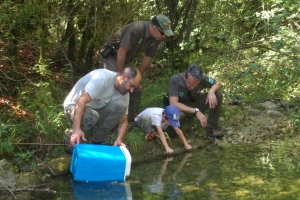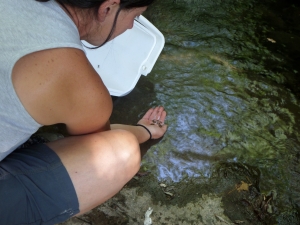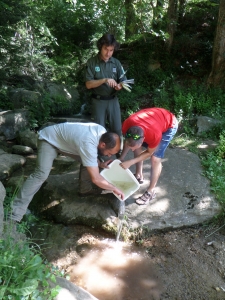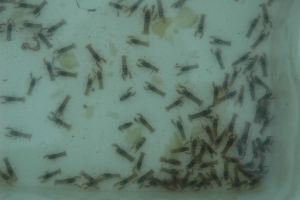More than 4,500 Crayfish have been released during last spring
One of the main aims of the LIFE Potamo Fauna project has been to conserve and recover the White-clawed Crayfish in the river basins of the Ter, Fluvià and Muga rivers
The European project LIFE Potamo Fauna "Conservation of river fauna of Community interest in the Natura 2000 network sites of the Ter, Fluvià and Muga river basins", in these four years of duration (2014-2017) has focused on conserving and recovering the White-clawed Crayfish (Austropotamobius pallipes), a species seriously threatened by the presence of invasive crayfish, such as the american species Procambarus clarkii. With this objective, every year the project releases specimens raised in captivity, what have been carried out at the Centre Reproductor de Cranc in Olot. This year, on the 15th, 20th and 22nd of June, different actions have been carried out, with a total of 4,592 released native crayfish. This year, in addition, it is expected to release or translate up to 6,000 individuals.
During the action to release them, the participants were the technicians from the Natural Park of the Volcanic Zone of the Garrotxa and Forestal Catalana, students and volunteers, and three agents of the Body of Rural Agents. The areas where they have been carried out were three streams of Collsacabra-Puigsacalm and Alta Garrotxa. These places are part of the protected natural areas of the Natura 2000 Network. Moreover, monitoring of the previously released individuals have been made, which have had positive results.
The native river Crayfish was a common species in most water courses in Southern Europe. At the end of the seventies, the fungal epizootic of the aphanomycosis (Aphanomyces astaci) was produced, which caused a drastic decline in the population. This disease was introduced by the american crayfishes, species that have spread rapidly through the country's rivers. The expansion of this malignancy has been accentuated by the recent expansion of two more exotic species, both of American origin and bearers of disease.
In the River Fluvià basin, for more than 20 years ago, technicians have been working with the knowledge of this species and for 10 years they have worked in the recovery plan. In 2004, the Centre Reproductor de Cranc in Olot was created, managed by the technical team of the Natural Park of the Volcanic Zone of La Garrotxa. Within the framework of the LIFE Potamo Fauna project, improvements have been made in the facilities to minimize diseases such as Saprophynia and thus to increase the production of crayfish. Today, there is a good stock of reproductive individuals of different hydrographic basins in the country, as well as young specimens from captive reproduction that will be used to increase the number of reproductive crayfish. The breeding individuals are from the three main basins of the Girona district (Fluvià, Ter and Muga), thus preserving the genetic diversity of each basin and working in the search for resistance against the disease, depending on the genetics of each population.




















